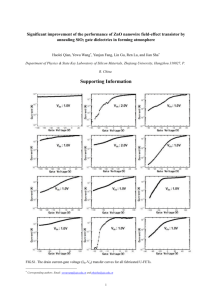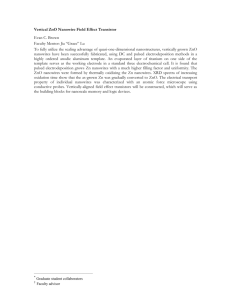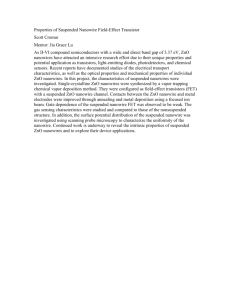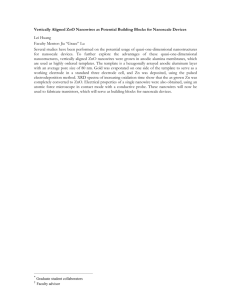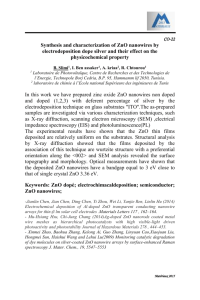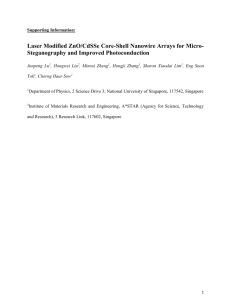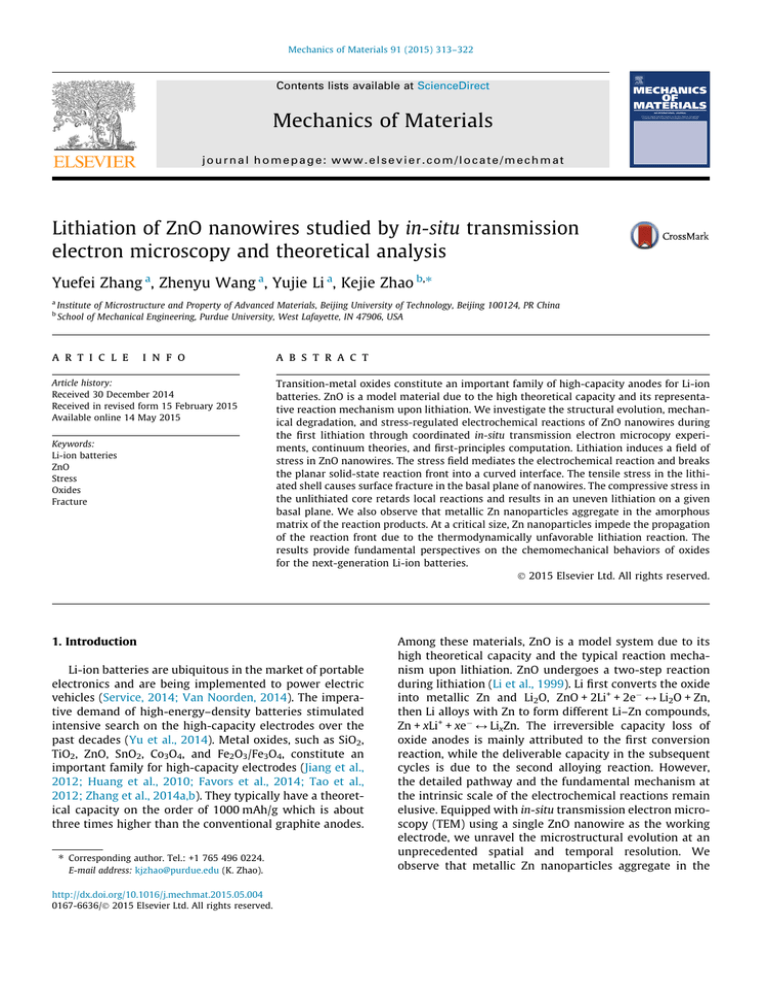
Mechanics of Materials 91 (2015) 313–322
Contents lists available at ScienceDirect
Mechanics of Materials
journal homepage: www.elsevier.com/locate/mechmat
Lithiation of ZnO nanowires studied by in-situ transmission
electron microscopy and theoretical analysis
Yuefei Zhang a, Zhenyu Wang a, Yujie Li a, Kejie Zhao b,⇑
a
b
Institute of Microstructure and Property of Advanced Materials, Beijing University of Technology, Beijing 100124, PR China
School of Mechanical Engineering, Purdue University, West Lafayette, IN 47906, USA
a r t i c l e
i n f o
Article history:
Received 30 December 2014
Received in revised form 15 February 2015
Available online 14 May 2015
Keywords:
Li-ion batteries
ZnO
Stress
Oxides
Fracture
a b s t r a c t
Transition-metal oxides constitute an important family of high-capacity anodes for Li-ion
batteries. ZnO is a model material due to the high theoretical capacity and its representative reaction mechanism upon lithiation. We investigate the structural evolution, mechanical degradation, and stress-regulated electrochemical reactions of ZnO nanowires during
the first lithiation through coordinated in-situ transmission electron microcopy experiments, continuum theories, and first-principles computation. Lithiation induces a field of
stress in ZnO nanowires. The stress field mediates the electrochemical reaction and breaks
the planar solid-state reaction front into a curved interface. The tensile stress in the lithiated shell causes surface fracture in the basal plane of nanowires. The compressive stress in
the unlithiated core retards local reactions and results in an uneven lithiation on a given
basal plane. We also observe that metallic Zn nanoparticles aggregate in the amorphous
matrix of the reaction products. At a critical size, Zn nanoparticles impede the propagation
of the reaction front due to the thermodynamically unfavorable lithiation reaction. The
results provide fundamental perspectives on the chemomechanical behaviors of oxides
for the next-generation Li-ion batteries.
Ó 2015 Elsevier Ltd. All rights reserved.
1. Introduction
Li-ion batteries are ubiquitous in the market of portable
electronics and are being implemented to power electric
vehicles (Service, 2014; Van Noorden, 2014). The imperative demand of high-energy–density batteries stimulated
intensive search on the high-capacity electrodes over the
past decades (Yu et al., 2014). Metal oxides, such as SiO2,
TiO2, ZnO, SnO2, Co3O4, and Fe2O3/Fe3O4, constitute an
important family for high-capacity electrodes (Jiang et al.,
2012; Huang et al., 2010; Favors et al., 2014; Tao et al.,
2012; Zhang et al., 2014a,b). They typically have a theoretical capacity on the order of 1000 mAh/g which is about
three times higher than the conventional graphite anodes.
⇑ Corresponding author. Tel.: +1 765 496 0224.
E-mail address: kjzhao@purdue.edu (K. Zhao).
http://dx.doi.org/10.1016/j.mechmat.2015.05.004
0167-6636/Ó 2015 Elsevier Ltd. All rights reserved.
Among these materials, ZnO is a model system due to its
high theoretical capacity and the typical reaction mechanism upon lithiation. ZnO undergoes a two-step reaction
during lithiation (Li et al., 1999). Li first converts the oxide
into metallic Zn and Li2O, ZnO + 2Li+ + 2e M Li2O + Zn,
then Li alloys with Zn to form different Li–Zn compounds,
Zn + xLi+ + xe M LixZn. The irreversible capacity loss of
oxide anodes is mainly attributed to the first conversion
reaction, while the deliverable capacity in the subsequent
cycles is due to the second alloying reaction. However,
the detailed pathway and the fundamental mechanism at
the intrinsic scale of the electrochemical reactions remain
elusive. Equipped with in-situ transmission electron microscopy (TEM) using a single ZnO nanowire as the working
electrode, we unravel the microstructural evolution at an
unprecedented spatial and temporal resolution. We
observe that metallic Zn nanoparticles aggregate in the
314
Y. Zhang et al. / Mechanics of Materials 91 (2015) 313–322
amorphous matrix of the reaction products. At a critical
size, Zn nanoparticles impede the propagation of the reaction front due to the thermodynamically unfavorable lithiation reaction.
In addition, ZnO provides an example to study the intimate coupling between mechanics and electrochemistry.
Lithiation causes a volumetric strain of 100% in ZnO
(Kushima et al., 2011). Such a large deformation induces
a field stress, which leads to fracture and drastic morphological changes. The mechanical degradation driven by the
electrochemical process of Li insertion and extraction is
inherent to high-capacity electrodes and often leads to
rapid capacity loss in the first few cycles (Zhang, 2011;
Zhao et al., 2011, 2012; Wan et al., 2014). Meanwhile,
mechanics influences the chemistry of lithiation in a significant manner. Stress affects reactions at the interface
between the electrode and electrolyte, the propagation of
solid–solid reaction front, diffusion of Li in electrode particles, and phase transformations of electrode materials
(Yang et al., 2014; Zhao et al., 2012; Haftbaradaran et al.,
2010; Pharr et al., 2012; Tang et al., 2011; McDowell
et al., 2012). In ZnO, we demonstrate discrete surface
cracks induced by tensile stresses in the lithiated shell.
The fracture surfaces provide fast channels for Li penetration that ultimately divides the nanowires into multiple
segments of nanoglass domains (Kushima et al., 2011).
The compressive stress in the unlithiated core, on the other
hand, causes retardation of local electrochemical reaction
and results in a cross-sectionally uneven lithiation.
Lithiation also results in significant embrittlement of the
oxide nanowire and leads to a transition from a pristine
material with resilient elasticity to a fragile structure in
the lithiated form.
The overall picture of characteristics in lithiation of ZnO
nanowires is depicted in Fig. 1. Once a reliable contact is
made between a single ZnO nanowire with the counter
electrode and the electrolyte Li/Li2O, Li ions diffuse quickly
on the nanowire surface, forming a thin wetting layer with
typical thickness of a few nanometers. The nanowire is first
lithiated radially and the extent of lithiation is limited by
the amount of Li transport through the thin wetting layer.
The solid-state reaction front (SSRF) primarily propagates
along the longitudinal direction of the nanowire away from
the electrolyte. The radial lithiation forms a structure of
lithiated shell and unlithiated core. A field of stress is associated with the core–shell geometry (Zhao et al., 2012).
While the tensile stress in the lithiated shell induces discrete surface cracks and facilitates Li transport through
the crack surfaces, the compressive stress in the pristine
core diminishes the thermodynamic driving force of the
electrochemical reaction and impedes the local lithiation.
The asymmetry of the characteristic stresses breaks the
planar SSRF into a curved interface that is a reminiscence
of Mullins–Sekerka interfacial instability (Mullins and
Sekerka, 1964). In addition, metallic Zn nanoparticles
aggregate in the amorphous matrix during the conversion
reaction. The size of these nanoparticles steadily increases
in the course of lithiation. The metallic phase largely blocks
the path of Li transport at a critical size, and reduces the
propagation velocity of the SSRF due to the thermodynamically unfavorable reaction with Li. These salient features
will be elaborated in great detail in the following sections.
2. Experimental procedures
2.1. Material synthesis and characterization
ZnO nanowires with the growth orientation [0 0 0 1]
were prepared on a Si (0 0 1) substrate by the
hollow-cathode discharge plasma chemical vapor deposition method. During the process, Ar was used as the
plasma forming gas, O2 as the reactive gas, and metal zinc
powder (99.99% purity) vaporized by plasma heating over
1100 °C as the zinc source. Details of the growth process
and the optimum conditions to obtain high-purity nanowires were reported elsewhere (Bian et al., 2008;
Chunqing et al., 2009). High-resolution transmission electron microscopy (HRTEM) was conducted using a
JEOL-2010 TEM operated at 200 kV. The chemical composition of the samples was detected using energy dispersive
X-ray spectroscopy (EDS, Oxford Instruments). The surface
and morphology were imaged using a scanning electron
microscopy (SEM, FEI Quanta 250, and JEOL 6500F).
Individual ZnO nanowires were fully characterized using
SEM, HRTEM, and energy dispersive X-ray (EDX) spectroscopy prior to starting the measurements on the electrochemical and mechanical properties. Fig. 2(a) shows a
SEM image of as-synthesized ZnO nanowires. The diameters are in between 80 and 500 nm, and the length is typically a few micrometers. Fig. 2(b) shows the wurtzite
structure of individual crystalline nanowires. A
Li 2 O
Li
surface cracks
Li + flux
Zn
SSRF
ZnO
amorphous matrix
Li + wetting layer
Fig. 1. Schematic illustration of the overall features of lithiation in ZnO nanowires. Li ions diffuse quickly on the nanowire surface, forming a thin wetting
layer with typical thickness of a few nanometers. The nanowire surface is first lithiated and the extent of lithiation is limited by Li transport through the thin
wetting layer. The primary solid-state reaction front (SSRF) propagates along the longitudinal direction of the nanowire away from the electrolyte. Metallic
Zn nanoparticles aggregate in the amorphous matrix of the reaction products. At a critical size, Zn nanoparticles impede the propagation of the reaction
front. Lithiation induces a field of tensile stress in the lithiated shell, and compressive stress in the unlithiated core. The tensile stress causes surface fracture
in the (0 0 0 1) basal plane of ZnO nanowires. The stress field regulates the lithiation reaction and breaks the planar SSRF into a curved interface.
Y. Zhang et al. / Mechanics of Materials 91 (2015) 313–322
315
Fig. 2. (a) A SEM image of as-synthesized ZnO nanowires. The diameters are in between 80 and 500 nm, and the length is typically a few micrometers. (b)
The wurtzite structure of individual crystalline ZnO nanowires. (c) A HRTEM image shows the atomistic structure of pristine ZnO nanowires. The image is
1
0 direction. The inset SAED pattern indicates the [0 0 0 1] growth direction of the nanowires.
viewed from the ½2 1
high-resolution TEM image in Fig. 2(c) further illustrates
the atomistic structure of pristine ZnO nanowires. The
1
0 direction. The inset
image is viewed from the ½2 1
selected area electron diffraction (SAED) pattern confirms
the [0 0 0 1] growth direction of the nanowires.
directly observed from the serial TEM images. In-situ bending experiments of individual nanowires before and after
lithiation were performed by moving the W tip with a precision of 1 nm in the X- or Y-direction.
2.2. In-situ experiments
3. Results and discussion
In-situ TEM observations were carried out using the
Nanofactory TEM-scanning tunneling microscopy (STM)
holder inside a JEOL-2010 TEM. The electron flux dose rate
was around 6 1019 e/(cm2 s). The point resolution was
0.19 nm. A CCD camera (Gatan 894) was used for the digital recording of the TEM images. A typical exposure time
was 0.2–1.0 s for each frame. The movies showing the
in-situ lithiation processes in the supplementary materials
were recorded by 2 frames per second. A few ZnO nanowires were attached to a gold (Au) rod with conductive silver epoxy as the working electrode. Li metal was scratched
by an electrochemically shaped tungsten (W) tip inside a
glove box. The Au and W tips were mounted on the station
of TEM-STM holder. The assembly holder was loaded into
the TEM chamber within a sealed plastic bag with an air
exposure time less than 5 s. By manipulating the
pizeo-driven stage with nanometer precision on the
TEM-STM holder, the Li2O covered Li metal came into contact with the single ZnO nanowire. Once a reliable contact
was made, a bias voltage of 3 V was applied to drive the
lithiation reaction of the ZnO nanowire. By accurately controlling the W tip toward the lithiated nanowire, a junction
was formed using in-situ electron beam induced deposition
(EBID) between the lithiated nanowire and the W tip.
Uniaxial tension was applied to the lithiated nanowire by
a controlled displacement to pull the W tip away from
the nanowire. Fracture surface of lithiated nanowires was
Fig. 3(a) shows the schematic of the experimental setup
of a nano-battery, consisting of a ZnO nanowire as the
working electrode, Li/Li2O as the counter electrode and
the electrolyte, and Au and W rods as the current collectors. Precautions were taken to avoid the beam effects on
lithiation reactions (Zhang et al., 2014a). In-situ experiments are carried out with a low dose rate of electron flux.
During the entire experiments, the electron beam is distributed to a large illumination area with the diameter of
50 lm. We avoid the focus of beams to a small area that
may induce undesired radiation effects. Similar experimental setup was also reported by other groups (Karki
et al., 2013; Gu et al., 2013; McDowell et al., 2013; Wang
et al., 2012; Liu et al., 2012). Fig. 3(b) shows the integrated
nanowire at the initial state. When a bias voltage of 3 V is
applied to the nanowire against Li, the reaction front propagates primarily along the longitudinal direction of the
nanowire. After lithiation, the reacted part is elongated
50% and the diameter expands 30%. The total volume
expansion was estimated about 150%. The longitudinal
swelling of the nanowire is constrained. The constrained
deformation causes bending of the nanowire. As shown
in Fig. 3(c), bending is localized at the lithiated end, indicating that the lithiated phase is significantly more compliant than the pristine material. The time evolution of a
single nanowire during lithiation is shown in the supplementary Movie 1.
316
Y. Zhang et al. / Mechanics of Materials 91 (2015) 313–322
Fig. 3. (a) Schematic of a nano-battery consisting of a ZnO nanowire as the working electrode, Li/Li2O as the counter electrode and the electrolyte. Au and W
rods are current collectors. (b) A single ZnO nanowire integrated in the nano-battery. (c) Morphological change of the nanowire during the first lithiation.
The constrained swelling causes dramatic bending at the lithiated end.
Previous studies on the reaction mechanism between Li
and ZnO are informative (Liu et al., 2009; Wang et al.,
2009; Su et al., 2013; Yang et al., 2013; Wu and Chang,
2013; Bresser et al., 2013). Upon lithiation, ZnO undergoes
a two-step reaction. Li first converts the oxide into metallic
Zn, leaving Zn nanoparticles dispersed in the amorphous
matrix of Li2O and Li–Zn–O alloys. Li further alloys with
Zn to form Li–Zn compounds. We identify the phase evolution along the reaction path by performing electron diffraction analysis. We mark four areas, I, II, III, and IV, in
Fig. 4(a), and the corresponding diffraction patterns are
shown in Fig. 4(b). Overall, we see a transition from an
amorphous matrix with polycrystalline phases to the single crystalline zone along the lithiation path. In the reacted
parts, I, II, and III, the reaction products crystalline Zn, LiZn,
Li2O, and residual ZnO are dispersed in the amorphous
matrix. The decreasing intensity of the amorphous halos
implies gradually lower degree of lithiation along the reaction path.
While there is little debate on the final products of lithiated ZnO, the fundamental mechanism of the reaction
pathway remains elusive. For example, how does metallic
Zn nanocrystals aggregate and grow in the course of lithiation? Does the inhomogeneous dispersion of the metallic
particles impair the propagation of lithiation? To answer
the questions, we closely monitor the structural evolution
together with the migration of the reaction front as a function of time. We use the diffraction patterns in Fig. 4 to
identify the location of the reaction front. Fig. 5(a)–(f)
show the propagation of the lithiation front in a single
ZnO nanowire. Fig. 5(g) plots the migration distance versus
time. The nearly linear behavior in the major stage of
lithiation indicates that the rate of lithiation is limited by
short-range processes at the solid-state reaction front,
such as breaking and forming atomic bonds, rather than
by the long-range diffusion of Li through the amorphous
matrix. Such a rate-limiting process is a norm in heterogeneous reactions involving crystalline materials (Zhao et al.,
2012; Cubuk et al., 2013; Yang et al., 2012). We note that
the size of Zn nanoparticles steadily increases as lithiation
proceeds. At a critical size, the nanocrystals will largely
block the path of Li transport, and reduce the propagation
velocity of the reaction front, as shown in the inset snapshot of Fig. 5(g).
The retardation of the reaction front by Zn nanocrystals
originates from the thermodynamically unfavorable
Li intercalation into Zn. We employ first-principles
computational methods to compare the energetics of Li
insertion into Zn and ZnO crystal lattices. Calculations
based on Density Functional Theory are performed
using Vienna Ab-initio Simulation Package (VASP).
Projector-augmented-wave potentials are used to mimic
the ionic cores, while the generalized gradient approximation in the Perdew–Burke–Ernzerh flavor is employed for
the exchange and correlation functional (Kresse and
Furthmüller, 1996; Kresse and Joubert, 1999). In particular,
we treat 1s22s1 orbitals as the valance configuration for Li.
The atomic structures and system energy are calculated
with an energy cutoff of 500 eV. The energy optimization
is considered complete when the magnitude of the force
on each atom is smaller than 0.02 eV Å1. A unit cell of
Zn with the hexagonal close packed (HCP) structure is constructed containing 16 atoms. The lattice parameters are
a = 5.27 Å, b = 4.56 Å, c = 10.32 Å. The unit cell of wurtzite
Y. Zhang et al. / Mechanics of Materials 91 (2015) 313–322
317
Fig. 4. A transition from the amorphous phase to the single crystalline zone along the lithiation path. Four areas are marked in (a). The corresponding
diffraction patterns indicate that the reaction products crystalline Zn, LiZn, Li2O, and residual ZnO are dispersed in the amorphous matrix. The decreasing
intensity of the amorphous halos implies gradually lower degree of lithiation along the reaction path. The diffraction patterns are used to identify the
location of the reaction front.
Fig. 5. (a)–(f) show the propagation of the lithiation front in a single ZnO nanowire during the first lithiation. (g) The migration distance of the reaction front
as a function of time. The nearly linear behavior in the major stage of lithiation indicates the rate-limiting step dominated by the interfacial reaction, rather
than by the long-range diffusion of Li through the amorphous matrix. The propagation of reaction front is impeded at a critical size of aggregated Zn
nanoparticles, as shown in the inset snapshot.
ZnO contains 16 Zn atoms and 16 O atoms. The lattice
parameters are a = 6.57 Å, b = 5.68 Å, c = 10.62 Å. Li insertion into a HCP structure is energetically favorable at the
octahedral interstitial sites, Fig. 6 (Kushima et al., 2011;
Huang et al., 2009). We compute the formation energy
for a single Li insertion into the crystals. We take the
energy of Zn/ZnO (EZn/EZnO) and the energy of a Li atom
in its bulk form (ELi) as the reference energies, with
ELi–Zn/ELi–ZnO being the total energy of the system containing one Li in the cell. The formation energy Ef is calculated
as Ef ¼ ELiZn=LiZnO EZn=ZnO ELi . The formation energies
for a single Li in ZnO and Zn are 0.07 eV and 0.15 eV.
Apparently the structure of lithiated ZnO is thermodynamically more stable and alloying of Li with Zn is energetically
unfavorable. In addition, we find the partial molar
volume of Li in ZnO and Zn as OLi in ZnO = 9.96 Å3 and
OLi in Zn = 28.54 Å3, respectively. The large discrepancy also
indicates that Li intercalation in Zn lattice is less comfortable that the unit cell has to be largely stretched to accommodate the guest species. The simple calculation shows a
qualitative comparison of the thermodynamic driving
forces of lithiation in Zn and the oxide. A systematic
318
Y. Zhang et al. / Mechanics of Materials 91 (2015) 313–322
Fig. 6. Atomic structures of bulk Zn, (a), and ZnO, (b). Li insertion is energetically favorable at the octahedral interstitial sites. The grey, red, and green
spheres represent the Zn, O, and Li atoms, respectively. (For interpretation of the references to color in this figure legend, the reader is referred to the web
version of this article.)
analysis of the energetics and evolution of atomistic structures at higher Li contents warrants further careful studies.
Nevertheless, the computation at low Li concentration provides insight on the sluggish lithiation reaction in Zn,
which is relevant to the experimental observation that
the aggregation of Zn nanocrystals reduces the migration
velocity of the reaction front.
More interestingly, lithiation of ZnO exemplifies
mechanical stress-regulated electrochemical reactions.
Radial lithiation of a ZnO nanowire forms a structure of
lithiated shell and unlithiated core. A field of stress is associated with the core–shell geometry. The lithiated phase
develops tensile stresses, potentially causing surface fracture and facilitating Li transport through the crack surfaces. On the contrary, a material element in the
unlithiated core is under a field of compressive stress,
retarding the local electrochemical reaction. To illustrate
the distinct feature of stresses, we consider a partially lithiated ZnO nanowire with its cross-section shown in Fig. 7.
We derive the stress field using the continuum theory of
finite deformation. We first note that, in order to accommodate a large volumetric strain of 150%, lithiated ZnO
must deform plastically (Zhao et al., 2011, 2012;
Nadimpalli et al., 2013). We represent a material element
in the reference configuration by its distance R from the
center, Fig. 7(a). At time t, the material element moves to
a place at a distance r from the center, Fig. 7(b). The function r(R, t) specifies the deformation kinematics. Due to the
mechanical constraint imposed by the crystalline ZnO in
the axial direction, the lithiated phase is assumed to
deform under the plane-strain conditions.
To focus on the main feature, we neglect the elasticity
of the lithiated material; we model the lithiated phase as
a rigid-plastic material with yield strength rY .
Consequently, the expansion of the shell is entirely due
to lithiation. Consider the shell of the lithiated phase
between the radii A and R. After lithiation, the core radius
becomes a, and the material element moves to a new position r. We assume that Li is injected slowly and has sufficient time to diffuse through the lithiated region. The
ratio of the volume of the lithiated shell over the volume
of pristine phase is represented as b. Thus,
R2 A2 þ bða2 A2 Þ ¼ r 2 a2 :
This equation gives the function r(R, t) once the kinetics
of the reaction front propagation aðAÞ is prescribed. We
write f ðAÞ ¼ ð1 þ bÞða2 A2 Þ. Therefore f ðAÞ fully specifies
the kinematics of the lithiated shell,
r¼
(a)
R
qffiffiffiffiffiffiffiffiffiffiffiffiffiffiffiffiffiffiffiffi
R2 þ f ðAÞ:
ð2Þ
The stretches can be calculated as
(b)
B
ð1Þ
kr ¼
b
A
a
ZnO
r
Li x ZnO
Fig. 7. Cross section of the core–shell structure of a ZnO nanowire during
lithiation. (a) In the reference state, an element of lithiated ZnO is
represented by its distance from the center R. The radius of the
unlithiated ZnO (core) is A, and the radius of the lithiated phase (shell)
B. (b) At time t, ZnO in the shell between the radii A and a is lithiated, and
the element R moves to a new position of radius r.
@r R
¼ ;
@R r
kh ¼
r
;
R
kz ¼ 1:
ð3Þ
By neglecting the elastic deformation of the lithiated
phase, the total expansion is only accommodated by the
plastic deformation. We calculate the strain components
from the stretches,
epr ¼ er ¼ log kr ; eph ¼ eh ¼ logkh ; epz ¼ ez ¼ logkz :
ð4Þ
To calculate the stress field, one has to consider the
incremental plastic deformation with respect to time.
Given Eqs. (3) and (4), we obtain that
depr ¼ 1
df ;
2r2
deph ¼
1
df ;
2r 2
depz ¼ 0:
ð5Þ
Y. Zhang et al. / Mechanics of Materials 91 (2015) 313–322
The equivalent plastic strain increment is
depeq ¼
rr ¼
rffiffiffiffiffiffiffiffiffiffiffiffiffiffiffiffiffiffi
2 p p
2
de de ¼ pffiffiffi df :
3 ij ij
3r 2
ð6Þ
We adopt the flow rule
sij ¼
pffiffiffi
3
sr ¼ rY ;
3
ð7Þ
pffiffiffi
3
sh ¼
rY ;
3
sz ¼ 0:
1
3
rii .
ð8Þ
rr rh ¼ sr sh ¼ pffiffiffi
2 3
rY :
3
ð9Þ
Consider the force balance of a material element in
lithiated ZnO
@ rr rr rh
þ
¼ 0;
@r
r
ð10Þ
the radial stress can be obtained by integrating Eq. (10), it
gives,
pffiffiffi
2 3
rY log r þ D:
3
ð11Þ
The integration constant D is determined by the
traction-free boundary condition, rr ðb; tÞ ¼ 0, such that
ð12Þ
The stress field in the elastic core (0 6 r 6 a) can be
solved using the familiar solution of Lamé problem
(Timoshenko and Goodier, 1970), it gives,
pffiffiffi
2 3
a
rY log
b
3
pffiffiffi
4 3
a
¼
v rY log
b
3
rr ¼ rh ¼
rz
and
rr ¼
rh
rz
2 rY p
de :
3 depeq ij
where sij is the deviatoric stress, defined as sij ¼ rij Therefore,
pffiffiffi
2 3
r
rY log
b
3
pffiffiffi
2 3 r
¼
rY log þ 1
b
3
pffiffiffi 2 3
r 1
¼
rY log þ :
b 2
3
319
ð13Þ
where v is the Poisson’s ratio of ZnO. The stress field would
be modified by the longitudinal propagation of the reaction
front because of the presence of mismatch strain at the
interface. Nevertheless, the key characteristics of tensile
stresses in the lithiated shell and compressive stresses in
the pristine core remain the same. As shown in the
closed-forms (12) and (13), the surface of the lithiated
shell is subject to tensile stresses in the hoop and axial
directions, while a material element in the unlithiated core
is under compressive stresses.
The mechanical stress contributes to the thermodynamic driving force of lithiation. In an example of
crystalline Si, the mechanical energy even may
counterbalance the electrochemical driving force of
Fig. 8. Time evolution of the curved reaction front. The transition from tensile stresses in the lithiated shell to compressive stresses in the unlithiated core
breaks the planar reaction front into a curved interface. The radius of curvature gradually decreases and the core is eventually lithiated as the reaction front
propagates.
320
Y. Zhang et al. / Mechanics of Materials 91 (2015) 313–322
lithiation and causes stagnation of the reaction front (Zhao
et al., 2012; McDowell et al., 2012). The change of free
energy due to stresses associated with an electrochemical
reaction can be written as DGm ¼ Xrm , where X represents the partial molar volume of Li, and rm the hydrostatic
stress. A negative DGm facilitates lithiation. As expected, a
tensile mean stress in the lithiated shell promotes lithiation, and a compressive mean stress in the unlithiated core
retards lithiation. The asymmetry of stresses in ZnO
nanowires breaks the planar reaction front into a curved
interface which is a phenomenon similar to the Mullins–
Sekerka instability for a moving liquid–solid interface
(Mullins and Sekerka, 1964). Fig. 8 shows the time evolution of the curved SSRF. The magnitude of compressive
stresses increases toward the core, dictating a gradually
decreasing driving force of lithiation from the surface to
the center of the nanowire. The pattern of the reaction
front shown in Fig. 8 corroborates the transition of the
stress state. The radius of curvature gradually decreases
and the core is eventually lithiated as the reaction front
propagates. Another noteworthy feature is the surface fracture induced by the tensile stresses in the lithiated phase.
Fig. 9 shows discrete surface cracks in the selected regions
in front of the reaction interface. The crack surfaces provide fast channels for Li penetration that divides the nanowire into multiple segments of glassy domains (Kushima
et al., 2011). Micro-cracks also exist in the reacted parts;
however, the crack morphologies are not as visible due to
the large volumetric swelling. Surface fracture of lithiated
ZnO and their complex interplay with the process of lithiation was extensively investigated in a previous study
(Kushima et al., 2011). This interesting phenomenon is
not the focus of present study.
Lithiation results in dramatic changes of the mechanical
properties of ZnO nanowires. Significant embrittlement
associated with lithiation has been observed in a variety
of materials; ZnO obeys this trend as well (Liu et al.,
2011; Zhao et al., 2011). We perform in-situ uniaxial tension experiments to a lithiated ZnO nanowire that lithiated
region and unlithiated part coexist. Such a partially lithiated material provides direct contrast of fracture strength
of the pristine structure versus the lithiated phase.
Fig. 10(a)–(e) show the snapshots of the nanowire during
uniaxial deformation. By repeating the experiments on
several nanowires, fracture exclusively occurs in the lithiated zone. Such an observation indicates that the fracture
strength of lithiated ZnO is lower than that in pure ZnO.
Fig. 10(f)–(g) illustrates the brittle failure of lithiated
region with sharp fracture edges. Kushima et al. performed
first-principles calculations and found that the elastic
modulus drops by about factor of two from ZnO to
Li0.25ZnO (Kushima et al., 2011). By assuming the same failure strain 0.2% for both ZnO and its lithiated form, we
may estimate that the fracture strength of ZnO nanowires
decreases at least by factor of two upon lithiation.
Supplementary Movies 2 and 3 shows the other comparison of mechanical behaviors in the two material states
by performing in-situ bending experiments. It clearly
Fig. 9. Surface cracks observed at the selected areas (b)–(d) on the (0 0 0 1) basal plane of ZnO nanowires.
Y. Zhang et al. / Mechanics of Materials 91 (2015) 313–322
321
Fig. 10. In-situ uniaxial tensile deformation of a lithiated ZnO nanowire. The nanowire is partially lithiated as shown in Fig. 5(f). Fracture occurs in the
lithiated zone, indicating a lower tensile strength of the lithiated phase in comparison with that of the pristine material. (f) and (g) Fracture surface of the
nanowire shows the feature of brittle failure.
demonstrates the dramatic change from the pristine material with resilient elasticity to a fragile structure in the
lithiated form.
4. Conclusions
We study the lithiation behavior of ZnO nanowires
using complementary in-situ transmission electron microcopy experiments, continuum theories, and first-principles
computation. From the standpoint of mechanics, ZnO is a
model system to understand the intimate coupling
between electrochemistry and mechanics, that is, electrochemical reactions induce a field of stress and often lead
to mechanical degradation of the lithiated material, meanwhile, the stress field significantly influences the thermodynamics and kinetics of the chemical reactions. ZnO
illustrates such features that tensile stresses in the lithiated shell cause discrete surface fractures and facilitate Li
transport, while compressive stresses in the unlithiated
core retard the local electrochemical reaction. The asymmetry of the stress field breaks the planer solid-state reaction front into a curved interface that is a reminiscence of
the well-established Mullins–Sekerka instability for a moving liquid–solid interface. In addition, we observe that
metallic Zn nanoparticles aggregate in the conversion reaction of ZnO. At a critical size, Zn nanoparticles will largely
block the path of Li transport and reduce the migration
velocity of the reaction front due to the thermodynamically unfavorable lithiation reaction. The inhomogeneous
dispersion and growth of metallic nanocrystals is a generic
phenomenon for oxides electrodes in Li-ion batteries
(Huang et al., 2010; Su et al., 2013; Wang et al., 2013).
The findings reported here are relevant to other electrochemical systems involving oxides and provide fundamental perspectives on the chemomechanical behaviors of
high-capacity electrodes at the intrinsic scales.
Acknowledgements
Y.Z. acknowledges the National Natural Science
Foundation – China funded project (11374027), Beijing
Natural Science Foundation (2132014), and Special
Projects for Development of National Major Scientific
Instruments and Equipment (2012YQ03007508). The
research project is supported by the start-up funds at
Purdue University. K.Z. is grateful for the support of
Haythornthwaite Foundation Initiation Grant from
American Society of Mechanical Engineering – United
States.
Appendix A. Supplementary data
Supplementary data associated with this article can be
found, in the online version, at http://dx.doi.org/10.1016/
j.mechmat.2015.05.004.
References
Bian, X.-C., Huo, C.-Q., Zhang, Y.-F., Chen, Q., 2008. Preparation and
photoluminescence of ZnO with nanostructure by hollow-cathode
discharge. Front. Mater. Sci. Chin. 2, 31–36.
Bresser, D. et al., 2013. Transition-metal-doped zinc oxide nanoparticles
as a new lithium-ion anode material. Chem. Mater. 25, 4977–4985.
Chunqing, H., Yuefei, Z., Fuping, L., Qiang, C., Yuedong, M., 2009. Different
shapes of nano-ZnO crystals grown in catalyst-free DC Plasma. Plasma
Sci. Technol. 11, 564.
Cubuk, E.D. et al., 2013. Morphological evolution of Si nanowires upon
lithiation: A first-principles multiscale model. Nano Lett. 13, 2011–
2015.
Favors, Z. et al., 2014. Stable cycling of SiO2 nanotubes as highperformance anodes for lithium-ion batteries. Sci. Rep. 4, 4605.
Gu, M. et al., 2013. Electronic origin for the phase transition from
amorphous LixSi to crystalline Li15Si4. ACS Nano 7, 6303–6309.
Haftbaradaran, H., Gao, H.J., Curtin, W.A., 2010. A surface locking
instability for atomic intercalation into a solid electrode. Appl. Phys.
Lett. 96, 091909.
322
Y. Zhang et al. / Mechanics of Materials 91 (2015) 313–322
Huang, G.-Y., Wang, C.-Y., Wang, J.-T., 2009. First-principles study of
diffusion of Li, Na, K and Ag in ZnO. J. Phys.: Condens. Matter 21,
345802.
Huang, J.Y. et al., 2010. In situ observation of the electrochemical
lithiation of a single SnO2 nanowire electrode. Science 330, 1515–
1520.
Jiang, J. et al., 2012. Recent advances in metal oxide-based electrode
architecture design for electrochemical energy storage. Adv. Mater.
24, 5166–5180.
Karki, K. et al., 2013. Hoop-strong nanotubes for battery electrodes. ACS
Nano 7, 8295–8302.
Kresse, G., Furthmüller, J., 1996. Efficient iterative schemes for ab initio
total-energy calculations using a plane-wave basis set. Phys. Rev. B
54, 11169.
Kresse, G., Joubert, D., 1999. From ultrasoft pseudopotentials to the
projector augmented-wave method. Phys. Rev. B 59, 1758.
Kushima, A. et al., 2011. Leapfrog cracking and nanoamorphization of ZnO
nanowires during in situ electrochemical lithiation. Nano Lett. 11,
4535–4541.
Li, H., Huang, X., Chen, L., 1999. Anodes based on oxide materials for
lithium rechargeable batteries. Solid State Ionics 123, 189–197.
Liu, J. et al., 2009. Carbon/ZnO nanorod array electrode with significantly
improved lithium storage capability. J. Phys. Chem. C 113, 5336–
5339.
Liu, Y. et al., 2011. Lithiation-induced embrittlement of multiwalled
carbon nanotubes. ACS Nano 5, 7245–7253.
Liu, X.H. et al., 2012. In situ atomic-scale imaging of electrochemical
lithiation in silicon. Nat. Nanotechnol. 7, 749–756.
McDowell, M.T. et al., 2012. Studying the kinetics of crystalline silicon
nanoparticle lithiation with in situ TEM. Adv. Mater. 24, 6034–
6041.
McDowell, M.T. et al., 2013. In situ TEM of two-phase lithiation of
amorphous silicon nanospheres. Nano Lett. 13, 758–764.
Mullins, W.W., Sekerka, R., 1964. Stability of a planar interface during
solidification of a dilute binary alloy. J. Appl. Phys. 35, 444–451.
Nadimpalli, S.P. et al., 2013. On plastic deformation and fracture in Si
films during electrochemical lithiation/delithiation cycling. J.
Electrochem. Soc. 160, A1885–A1893.
Pharr, M., Zhao, K.J., Wang, X.W., Suo, Z.G., Vlassak, J.J., 2012. Kinetics of
initial lithiation of crystalline silicon electrodes of lithium-ion
batteries. Nano Lett. 12, 5039–5047.
Service, R.F., 2014. Tanks for the batteries. Science 344, 352–354.
Su, Q., Dong, Z., Zhang, J., Du, G., Xu, B., 2013. Visualizing the
electrochemical reaction of ZnO nanoparticles with lithium by
in situ TEM: two reaction modes are revealed. Nanotechnology 24,
255705.
Tang, M., Belak, J.F., Dorr, M.R., 2011. Anisotropic phase boundary
morphology in nanoscale olivine electrode particles. J. Phys. Chem.
C 115, 4922–4926.
Tao, L.Q. et al., 2012. Co3O4 nanorods/graphene nanosheets
nanocomposites for lithium ion batteries with improved reversible
capacity and cycle stability. J. Power Sources 202, 230–235.
Timoshenko, S., Goodier, J.N., 1970. Theory of Elasticity, third ed.
Mcgraw-Hill College, Blacklick, OH).
Van Noorden, R., 2014. A better battery. Nature 507, 26–28.
Wan, J. et al., 2014. Two dimensional silicon nanowalls for lithium ion
batteries. J. Mater. Chem. A 2, 6051–6057.
Wang, H., Pan, Q., Cheng, Y., Zhao, J., Yin, G., 2009. Evaluation of ZnO
nanorod arrays with dandelion-like morphology as negative
electrodes for lithium-ion batteries. Electrochim. Acta 54, 2851–2855.
Wang, J.W. et al., 2012. Sandwich-lithiation and longitudinal crack in
amorphous silicon coated on carbon nanofibers. ACS Nano 6, 9158–
9167.
Wang, L. et al., 2013. Real-time in situ TEM studying the fading
mechanism of tin dioxide nanowire electrodes in lithium ion
batteries. Sci. Chin. Technol. Sci. 56, 2630–2635.
Wu, M.-S., Chang, H.-W., 2013. Self-Assembly of NiO-coated ZnO nanorod
electrodes with core–shell nanostructures as anode materials for
rechargeable lithium-ion batteries. J. Phys. Chem. C 117, 2590–2599.
Yang, H. et al., 2012. Orientation-dependent interfacial mobility governs
the anisotropic swelling in lithiated silicon nanowires. Nano Lett. 12,
1953–1958.
Yang, G., Song, H., Cui, H., Liu, Y., Wang, C., 2013. Ultrafast Li-ion battery
anode with superlong life and excellent cycling stability from strongly
coupled ZnO nanoparticle/conductive nanocarbon skeleton hybrid
materials. Nano Energy 2, 579–585.
Yang, H. et al., 2014. A chemo-mechanical model of lithiation in silicon. J.
Mech. Phys. Solids 70, 349–361.
Yu, H.C. et al., 2014. Designing the next generation high capacity battery
electrodes. Energy Environ. Sci. 7, 1760–1768.
Zhang, W.J., 2011. Lithium insertion/extraction mechanism in alloy
anodes for lithium-ion batteries. J. Power Sources 196, 877–885.
Zhang, Y., Li, Y., Wang, Z., Zhao, K., 2014a. Lithiation of SiO2 in Li-ion
batteries: in-situ transmission electron microscopy experiments and
theoretical studies. Nano Lett. 14, 7161–7170.
Zhang, L., Wu, H.B., Lou, X.W.D., 2014b. Iron-oxide-based advanced anode
materials for lithium-ion batteries. Adv. Energy Mater. 4, 1300958.
Zhao, K.J., Pharr, M., Cai, S.Q., Vlassak, J.J., Suo, Z.G., 2011. Large plastic
deformation in high-capacity lithium-ion batteries caused by charge
and discharge. J. Am. Ceram. Soc. 94, S226–S235.
Zhao, K.J., Pharr, M., Vlassak, J.J., Suo, Z.G., 2011. Inelastic hosts as
electrodes for high-capacity lithium-ion batteries. J. Appl. Phys. 109,
016110.
Zhao, K.J. et al., 2011. Lithium-assisted plastic deformation of silicon
electrodes in lithium-Ion batteries: A first-principles theoretical
study. Nano Lett. 11, 2962–2967.
Zhao, K., Pharr, M., Hartle, L., Vlassak, J.J., Suo, Z., 2012. Fracture and
debonding in lithium-ion batteries with electrodes of hollow coreshell nanostructures. J. Power Sources 218, 6–14.
Zhao, K.J. et al., 2012. Concurrent reaction and plasticity during initial
lithiation of crystalline silicon in lithium-ion batteries. J. Electrochem.
Soc. 159, A238–A243.
Zhao, K.J. et al., 2012. Reactive flow in silicon electrodes assisted by the
insertion of lithium. Nano Lett. 12, 4397–4403.

